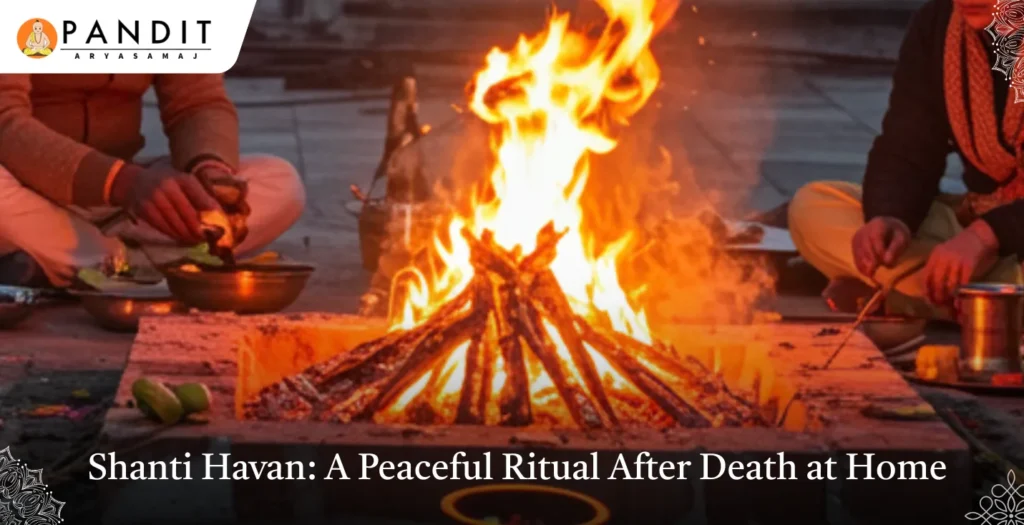When someone dies at home, it brings sorrow and a sense of loss. Family members feel confused and heartbroken. In Hindu tradition, people perform specific rituals to bring peace to the departed soul. One such important ritual is the Shanti Havan. For this, you have to call a Pandit for Shantihavan. This ceremony helps bring spiritual calmness to the house and to those who are grieving. Many families believe that this ritual not only honours the one who has passed away. But it also removes any negative energy that may remain in the home.
Understanding Shanti Havan and Its Purpose
This is a fire ceremony done to bring peace to the soul of the person who has died. This ceremony comes from the ancient Vedic traditions. Families usually perform this ritual within a few days after the person’s death. People believe the fire carries prayers to the higher energies. It helps the soul find its path. The ritual also purifies the home, which may have sad energy after a death. It is an emotional and spiritual process. It brings family members together, and they support each other in these tough times.
How do Families prepare for Shanti Havan?
People have to clean the home before the ceremony. They invite a Pandit for the shantihavan, usually someone who understands Vedic rituals. The priest brings the items needed for the Havan, The family sets up a clean space for the fire. They decorate it with flowers and holy symbols. Everyone dresses in simple clothes, usually white. This is to show respect to the one who has died. The priest gives instructions to the family. They explain the meaning behind each part of the ceremony. Everyone participates in chanting and offering items into the fire during the Havan.
What Happens During the Ceremony?
The priest lights the fire in a special way during the Shanti Havan. The fire sits inside a small structure called the Havan Kund. The family sits around the fire. The priest starts the ceremony with prayers and mantras from the Vedas. These chants are in Sanskrit. They ask for peace and guidance for the departed soul. As the mantras continue, family members offer samagri into the fire. Each offering goes with a chant, and the flames carry the prayers upwards. The sound of the mantras and the sight of the fire help create a spiritual feeling in the home.
The Role of Family Members in the Ritual
They sit together during the ceremony and take part in offering ingredients into the fire. Usually, the eldest son leads the family in the ritual. Women and children also take part by chanting and quietly praying. The panditji explains each step. They help everyone stay connected to the purpose of the ritual. Family members feel emotional during the ceremony. But the act of doing something together helps ease the pain. The ritual becomes a way for the family to say goodbye with love and dignity.
Spiritual and Emotional Importance of Shanti Havan
The act of performing the ritual gives people a chance to grieve in a respectful and meaningful way. The fire symbolises light and hope. The prayers give strength. Families believe that this ceremony helps the soul reach peace. It protects the home from further sadness. The atmosphere during and after the Havan feels lighter. For many people, it is a step forward in the process of healing and letting go. The family finds comfort in the belief that their loved one is now at peace.
When and Where Shanti Havan Is Performed
Families usually perform this puja within the first thirteen days after death. Some choose to do it on the tenth or thirteenth day. It depends on their tradition and the advice of the priest. The ceremony happens in the same home where the death occurred. If the family has moved and cannot hold the ritual at home, they sometimes do it at a temple. What matters most is the intention and devotion of the people taking part. The ritual does not need to be grand. Even a simple Havan, done with a pure heart, carries strong spiritual power.
How Communities Support the Family During the Puja
Neighbours and close friends join the family during the Shanti Havan. They offer help by arranging things. This support helps the grieving family feel less alone. Some people bring flowers and light incense to pay their respects. Everyone remains silent to keep the peace of the ceremony. The presence of the community adds warmth and strength to the event. It reminds the family that they are not alone in their sorrow. The shared prayers and good wishes create a strong and positive energy in the home.
Changes in How People Perform Shanti Havan Today
In modern times, some families perform shorter versions of the ritual. If a Pandit for Shantihavan is not available in person, some families perform the ritual with online guidance and video calls. Still, the heart of the ritual stays the same. Families light a fire. They chant mantras and offer prayers. Technology has made it easier for relatives living far away to take part. Even though the method has changed slightly, the meaning that the Shanti Havan brings remains strong. It continues to be a powerful and loving way to say farewell.
Conclusion
The Shanti Havan is a sacred way to say goodbye to a loved one who has passed away at home. It brings calmness to the departed soul. It gives strength to those left behind. This ancient tradition connects people with their faith and their emotions. The fire and the mantras help to bring healing. Families find peace in knowing they have honoured their loved one with care and respect. If you want panditji for any shantihavan, contact Pandit Arya Samaj. For any assistance, we have a skilled support team.

